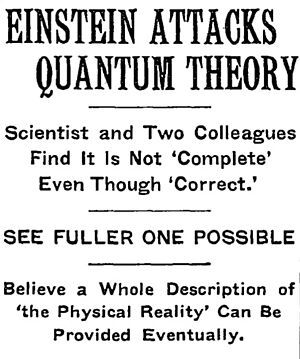Quantum entanglement facts for kids
Quantum entanglement is a super strange and special connection that can happen between tiny particles. Imagine two coins that, even when far apart, always land on the same side – if one is heads, the other is heads, and if one is tails, the other is tails. Quantum entanglement is a bit like that, but much weirder! It's one of the most puzzling ideas in quantum mechanics, which is the science of how the smallest things in the universe work.
Contents
What is Quantum Entanglement?
Normally, when we look at tiny particles, we think of each one as having its own unique "state" or set of properties. But sometimes, two or more particles can interact and become linked together. When this happens, they become "entangled."
When particles are entangled, they no longer have their own separate states. Instead, they act like a single unit. You can only describe the whole group of entangled particles together, not each one individually. It's like they share a secret code that connects them, no matter how far apart they are.
Why Particles Become Entangled
Particles can become entangled when they interact with each other. Think of it like two billiard balls hitting each other. Before they hit, they have their own movements. After they hit, their movements are connected. For tiny particles, these interactions are much more complex.
One important rule in physics is that certain things, like the total momentum (how much "oomph" something has when it moves), must stay the same before and after particles interact. Even though we can't know the exact momentum of each tiny particle, we know the total momentum of the entangled pair stays constant. To make sure this rule is followed, the particles have to be described as one linked system, not two separate ones.
No Secret Messages
Even though entangled particles are connected, they don't send messages to each other. There's no secret signal traveling between them. It's not like one particle says, "I'm going this way, so you must go that way!" Instead, they are always linked, acting as if they are one single thing.
The History of Entanglement
The idea of quantum entanglement was so strange that even Albert Einstein didn't like it! He called it "spooky action at a distance." Einstein, along with his friends Boris Podolsky and Nathan Rosen, thought this "spooky" connection meant that quantum mechanics wasn't a complete theory. He believed there must be some hidden information that we just didn't know about yet.
Erwin Schrödinger, another famous scientist, also talked about entanglement. He used the famous example of Schrödinger's cat to show how weird quantum mechanics could be.
Years later, a scientist named John Bell came up with a way to test if this "spooky action" was real or not. Experiments based on Bell's ideas proved that entanglement really does happen between tiny particles.
What Can Entanglement Be Used For?
Scientists are very excited about using quantum entanglement for amazing new technologies. Some ideas include:
- Super-secret messages: Imagine sending messages that are impossible for anyone else to read!
- Faster computers: Building computers that are much more powerful than anything we have today, called quantum computers.
However, entanglement is very delicate. It's easily broken, which makes it hard to use. Scientists are working hard to make entangled systems stronger and last longer so we can use them more easily.
You can't use entanglement by itself to send information faster than light. While changing one entangled particle might affect its partner, you can't control exactly what change will happen. The outcome is random. To truly "teleport" information (which is called quantum teleportation), you still need to send some regular information (like a phone call or an email) about the first particle. Without that extra information, you can't tell if a particle is part of an entangled pair or just a single particle. This means entanglement doesn't break the rule that nothing can travel faster than the speed of light.
Images for kids
See also
 In Spanish: Entrelazamiento cuántico para niños
In Spanish: Entrelazamiento cuántico para niños



